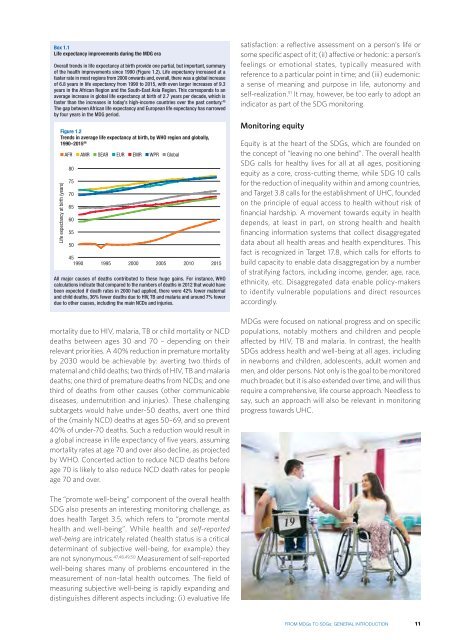Create successful ePaper yourself
Turn your PDF publications into a flip-book with our unique Google optimized e-Paper software.
Box 1.1<br />
Life expectancy improvements during the MDG era<br />
Overall trends in life expectancy at birth provide one partial, but important, summary<br />
of the health improvements since 1990 (Figure 1.2). Life expectancy increased at a<br />
faster rate in most regions <strong>from</strong> 2000 onwards and, overall, there was a global increase<br />
of 6.8 years in life expectancy <strong>from</strong> 1990 <strong>to</strong> 2015, with even larger increases of 9.3<br />
years in the African Region and the South-East Asia Region. This corresponds <strong>to</strong> an<br />
average increase in global life expectancy at birth of 2.7 years per decade, which is<br />
faster than the increases in <strong>to</strong>day’s high-income countries over the past century. 45<br />
The gap between African life expectancy and European life expectancy has narrowed<br />
by four years in the MDG period.<br />
Figure 1.2<br />
Trends in average life expectancy at birth, by WHO region and globally,<br />
1990–2015 46<br />
Life expectancy at birth (years)<br />
AFR AMR SEAR EUR EMR WPR Global<br />
80<br />
75<br />
70<br />
65<br />
60<br />
55<br />
50<br />
45<br />
1990 1995 2000 2005 2010 2015<br />
All major causes of deaths contributed <strong>to</strong> these huge gains. For instance, WHO<br />
calculations indicate that compared <strong>to</strong> the numbers of deaths in 2012 that would have<br />
been expected if death rates in 2000 had applied, there were 42% fewer maternal<br />
and child deaths, 36% fewer deaths due <strong>to</strong> HIV, TB and malaria and around 7% fewer<br />
due <strong>to</strong> other causes, including the main NCDs and injuries.<br />
mortality due <strong>to</strong> HIV, malaria, TB or child mortality or NCD<br />
deaths between ages 30 and 70 – depending on their<br />
relevant priorities. A 40% reduction in premature mortality<br />
by 2030 would be achievable by: averting two thirds of<br />
maternal and child deaths; two thirds of HIV, TB and malaria<br />
deaths; one third of premature deaths <strong>from</strong> NCDs; and one<br />
third of deaths <strong>from</strong> other causes (other communicable<br />
diseases, undernutrition and injuries). These challenging<br />
subtargets would halve under-50 deaths, avert one third<br />
of the (mainly NCD) deaths at ages 50–69, and so prevent<br />
40% of under-70 deaths. Such a reduction would result in<br />
a global increase in life expectancy of five years, assuming<br />
mortality rates at age 70 and over also decline, as projected<br />
by WHO. Concerted action <strong>to</strong> reduce NCD deaths before<br />
age 70 is likely <strong>to</strong> also reduce NCD death rates for people<br />
age 70 and over.<br />
satisfaction: a reflective assessment on a person’s life or<br />
some specific aspect of it; (ii) affective or hedonic: a person’s<br />
feelings or emotional states, typically measured with<br />
reference <strong>to</strong> a particular point in time; and (iii) eudemonic:<br />
a sense of meaning and purpose in life, au<strong>to</strong>nomy and<br />
self-realization. 51 It may, however, be <strong>to</strong>o early <strong>to</strong> adopt an<br />
indica<strong>to</strong>r as part of the SDG moni<strong>to</strong>ring.<br />
Moni<strong>to</strong>ring equity<br />
Equity is at the heart of the SDGs, which are founded on<br />
the concept of “leaving no one behind”. The overall health<br />
SDG calls for healthy lives for all at all ages, positioning<br />
equity as a core, cross-cutting theme, while SDG 10 calls<br />
for the reduction of inequality within and among countries,<br />
and Target 3.8 calls for the establishment of UHC, founded<br />
on the principle of equal access <strong>to</strong> health without risk of<br />
financial hardship. A movement <strong>to</strong>wards equity in health<br />
depends, at least in part, on strong health and health<br />
financing information systems that collect disaggregated<br />
data about all health areas and health expenditures. This<br />
fact is recognized in Target 17.8, which calls for efforts <strong>to</strong><br />
build capacity <strong>to</strong> enable data disaggregation by a number<br />
of stratifying fac<strong>to</strong>rs, including income, gender, age, race,<br />
ethnicity, etc. Disaggregated data enable policy-makers<br />
<strong>to</strong> identify vulnerable populations and direct resources<br />
accordingly.<br />
MDGs were focused on national progress and on specific<br />
populations, notably mothers and children and people<br />
affected by HIV, TB and malaria. In contrast, the health<br />
SDGs address health and well-being at all ages, including<br />
in newborns and children, adolescents, adult women and<br />
men, and older persons. Not only is the goal <strong>to</strong> be moni<strong>to</strong>red<br />
much broader, but it is also extended over time, and will thus<br />
require a comprehensive, life course approach. Needless <strong>to</strong><br />
say, such an approach will also be relevant in moni<strong>to</strong>ring<br />
progress <strong>to</strong>wards UHC.<br />
The “promote well-being” component of the overall health<br />
SDG also presents an interesting moni<strong>to</strong>ring challenge, as<br />
does health Target 3.5, which refers <strong>to</strong> “promote mental<br />
health and well-being”. While health and self-reported<br />
well-being are intricately related (health status is a critical<br />
determinant of subjective well-being, for example) they<br />
are not synonymous. 47,48,49,50 Measurement of self-reported<br />
well-being shares many of problems encountered in the<br />
measurement of non-fatal health outcomes. The field of<br />
measuring subjective well-being is rapidly expanding and<br />
distinguishes different aspects including: (i) evaluative life<br />
FROM MDGs TO SDGs: GENERAL INTRODUCTION<br />
11


